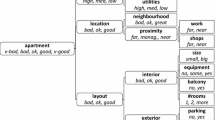Abstract
The paper presents an approach to the development, improvement, and modification of multi-criteria methods that are used in the analysis of complex systems. This approach is based on the typical scheme of the multi-criteria decision-making method. Changes introduced to its stages allow the modification and improvement of the available methods, as well as development of new ones. The possibility of practical use of the proposed approach is illustrated by an example of the development of a new method whose efficiency is confirmed by respective calculations.
Similar content being viewed by others
References
M. M. Potomkin, “Evaluating the validity of multicriteria decision-making,” Cybern. Syst. Analysis, Vol. 54, No. 6, 930–935 (2018).
N. V. Semenova, L. N. Kolechkina, and A. N. Nagorna, “An approach to solving discrete vector optimization problems over a combinatorial set of permutations,” Cybern. Syst. Analysis, Vol. 44, No. 3, 441–451 (2008).
N. V. Semenova and L. N. Kolechkina, “A polyhedral approach to solving multicriterion combinatorial optimizazion problems over sets of polyarrangements,” Cybern. Syst. Analysis, Vol. 45, No. 3, 438–445 (2009).
A. Z. Sarraf, A. Mohaghar, and H. Bazargani, “Developing TOPSIS method using statistical normalization for selecting knowledge management strategies,” J. of Industrial Engineering and Management, Vol. 6, No. 4, 860–875 (2013).
O. I. Larichev, The Theory and Methods of Decision-Making, as well as Chronicles of Events in Magic Countries [in Russian], Logos, Moscow (2000).
F. S. Novik and Ya. B. Arsov, Optimization of Metal Technology Processes by the Methods of Design of Experiments [in Russian], Mashynostroenie, Moscow; Tekhnika, Sofia (1980).
O. M. Zagorka, S. P. Mosov, A. I. Sbitnev, and P. I. Stuzhuk, Elements of the Analysis of Complex Military-Oriented Systems [in Ukrainian], NAOU, Kyiv (2005).
P. Chatterjee and S. Chakraborty, “Flexible manufacturing system selection using preference ranking methods: A comparative study,” Intern. J. of Industrial Engineering Computations, Vol. 5, Iss. 2, 315–338 (2014).
S. Hajkowicz and A. Higgins, “A comparison of multiple criteria analysis techniques for water resource management,” Europ. J. of Operational Research, Vol. 184, Iss. 1, 255–265 (2008).
W. Deni, O. Sudana, and A. Sasmita, “Analysis and implementation fuzzy multi-attribute decision making SAW method for selection of high achieving students in faculty level,” Intern. J. of Computer Science Issues, Vol. 10, Iss. 1, No. 2, 674–680 (2013).
M. Madić, V. Gecevska, M. Radovanović, and D. Petković, “Multi-criteria economic analysis of machining processes using the WASPAS method,” J. of Production Engineering, Vol. 17, No. 2, 79–82 (2014).
G. Anand and R. Kodali, “Selection of lean manufacturing systems using the PROMETHEE,” J. of Modelling in Management. Vol. 3, Iss. 1, 40–70 (2008).
L. F. A. M. Gomes, L. A. D. Rangel, and F. J. C. Maranhãoc, “Multicriteria analysis of natural gas destination in Brazil: An application of the TODIM method,” Mathematical and Computer Modelling, Vol. 50, Iss. 1–2, 92–100 (2009).
M. F. El-Santawy, “A VIKOR method for solving personnel training selection problem,” Intern. J. of Computing Science, Vol. 1, No. 2, 9–12 (2012).
W. K. Brauers and E. K. Zavadskas, “Robustness of the multi-objective MOORA method with a test for the facilities sector,” Technological and Economic Development of Economy,” Vol. 15, Iss. 2, 352–375 (2009).
T. Poklepović and Z. Babić, “Stock selection using a hybrid MCDM approach,” Croatian Operational Research Review, Vol. 5, No. 2, 273–290 (2014).
M. Madić, D. Petković, and M. Radovanović, “Selection of non-conventional machining processes using the OCRA method,” Serbian J. of Management,” Vol. 10, No. 1, 61–73 (2015).
P. Chatterjee and S. Chakraborty, “Gear material selection using complex proportional assessment and additive ratio assessment-based approaches: A comparative study,” Intern. J. of Materials Science and Engineering, Vol. 1, No. 2, 104–111 (2013).
D. Petković, M. Madić, and G. Radenković, “Selection of the most suitable non-conventional machining processes for ceramics machining by using Mcdms,” Science of Sintering, Vol. 47, No. 2, 229–235 (2015).
S. L. Blyumin and I. A. Shuikova, Models and Methods of Decision-Making Under Uncertainty [in Russian], LEGI, Lipetsk (2001).
S. A. Us, Methods of Decision-Making [in Russian], National Mining University, Dnepropetrovsk (2012).
H. Sen and M.F. Demiral, “Hospital location selection with grey system theory,” Europ. J. of Economics and Business Studies, Vol. 2, Iss. 2, 66–79 (2016).
I. Ertugrul, T. Oztas, A. Ozcil, and G. Z. Oztas, “Grey relational analysis approach in academic performance comparison of university: A case study of Turkish universities,” Europ. Scientific J., Spec. Ed., June, 128–139 (2016).
F. Ecer and A. Boyukaslan, “Measuring performances of football clubs using financial ratios: The gray relational analysis approach,” American J. of Economics. Vol. 4, No. 1, 62–71 (2014).
R. A. Krohling and T. T. M. De Souza, “F-TODIM: An application of the fuzzy TODIM method to rental evaluation of residential properties,” in: Simposio Barsileiro de Pesquisa Operacional, September 24–28, 2012, Rio de Janeiro, Brazil (2012), pp. 431–443.
M. Sevkli, “An application of the fuzzy ELECTRE method for supplier selection,” Intern. J. of Production Research, Vol. 48, Iss. 12, 3393–3405 (2010).
C.-C. Lo, D.-Y. Chen, C.-F. Tsai, and K.-M. Chao, “Service selection based on fuzzy TOPSIS method,” in: 24th IEEE Intern. Conf. on Advanced Information Networking and Applications Workshops, April 20–13, 2010, Perth, Australia (2010), pp.367–372.
Author information
Authors and Affiliations
Corresponding author
Additional information
Translated from Kibernetika i Sistemnyi Analiz, No. 6, November–December, 2019, pp. 99–109.
Rights and permissions
About this article
Cite this article
Potomkin, M.M., Dublian, O.V. & Khomchak, R.B. Approach to the Development, Improvement, and Modification of Multi-Criteria Decision-Making Methods. Cybern Syst Anal 55, 967–977 (2019). https://doi.org/10.1007/s10559-019-00207-7
Received:
Published:
Issue Date:
DOI: https://doi.org/10.1007/s10559-019-00207-7




